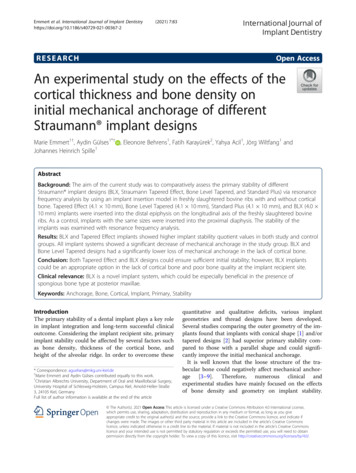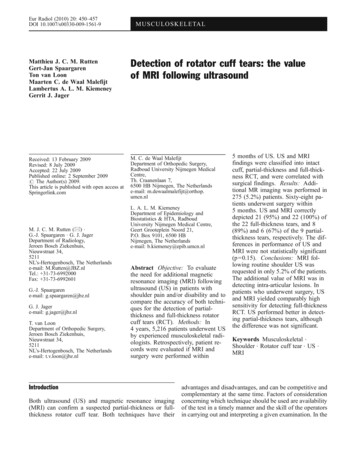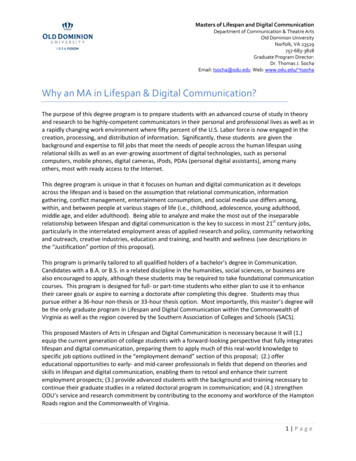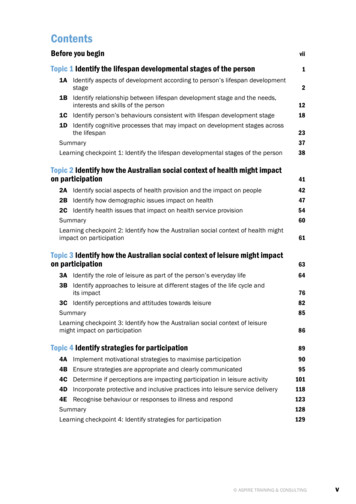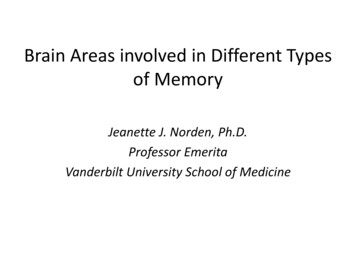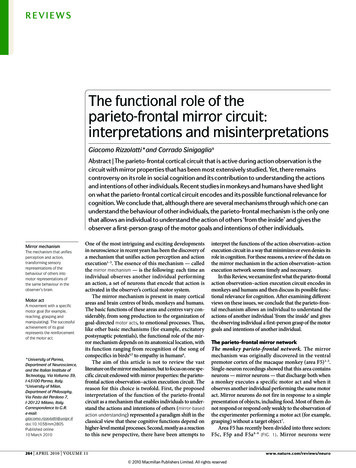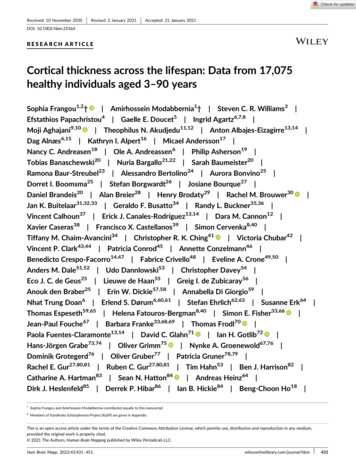
Transcription
Received: 10 November 2020Revised: 2 January 2021Accepted: 21 January 2021DOI: 10.1002/hbm.25364RESEARCH ARTICLECortical thickness across the lifespan: Data from 17,075healthy individuals aged 3–90 yearsSophia Frangou1,2† Amirhossein Modabbernia1† Steven C. R. Williams3Efstathios Papachristou4 Gaelle E. Doucet5 Ingrid Agartz6,7,8 Theophilus N. Akudjedu11,12 Anton Albajes-Eizagirre13,14Moji Aghajani9,10Dag Alnæs6,15 Kathryn I. Alpert16 Micael Andersson17 Nancy C. Andreasen18 Ole A. Andreassen6 Philip Asherson19 Tobias Banaschewski20 Nuria Bargallo21,22 Sarah Baumeister20 Ramona Baur-Streubel23 Alessandro Bertolino24 Aurora Bonvino25Dorret I. Boomsma25 Stefan Borgwardt26 Josiane Bourque27 Daniel Brandeis20 Alan Breier28 Henry Brodaty29 Rachel M. Brouwer30Jan K. Buitelaar31,32,33 Geraldo F. Busatto34 Randy L. Buckner35,36 Vincent Calhoun37 Erick J. Canales-Rodríguez13,14 Dara M. Cannon12 Xavier Caseras38 Francisco X. Castellanos39 Simon Cervenka8,40 Victoria Chubar42 Tiffany M. Chaim-Avancini34 Christopher R. K. Ching41Vincent P. Clark43,44 Patricia Conrod45 Annette Conzelmann46 Benedicto Crespo-Facorro14,47 Fabrice Crivello48 Eveline A. Crone49,50 Anders M. Dale51,52 Udo Dannlowski53 Christopher Davey54 Eco J. C. de Geus25 Lieuwe de Haan55 Greig I. de Zubicaray56 Anouk den Braber25 Erin W. Dickie57,58 Annabella Di Giorgio59 Nhat Trung Doan6 Erlend S. Dørum6,60,61 Stefan Ehrlich62,63 Susanne Erk64 Thomas Espeseth59,65 Helena Fatouros-Bergman8,40 Simon E. Fisher33,66 Jean-Paul Fouche67 Barbara Franke33,68,69 Thomas Frodl7013,1471Paola Fuentes-Claramonte David C. Glahn Ian H. Gotlib72Hans-Jörgen Grabe73,74 Oliver Grimm75Dominik Grotegerd76 Oliver Gruber77 Nynke A. Groenewold67,76Patricia Gruner78,79 Rachel E. Gur27,80,81 Ruben C. Gur27,80,81 Catharine A. Hartman83 Sean N. Hatton84Dirk J. Heslenfeld85 †#Derrek P. Hibar86 Tim Hahn53 Ben J. Harrison82 Andreas Heinz64 Ian B. Hickie84 Beng-Choon Ho18 Sophia Frangou and Amirhossein Modabbernia contributed equally to this manuscriptMembers of Karolinska Schizophrenia Project (KaSP) are given in Appendix.This is an open access article under the terms of the Creative Commons Attribution License, which permits use, distribution and reproduction in any medium,provided the original work is properly cited. 2021 The Authors. Human Brain Mapping published by Wiley Periodicals LLC.Hum Brain Mapp. bm431
432FRANGOU ET AL.Pieter J. Hoekstra87 Sarah Hohmann20 33,68Martine HoogmanHilleke E. Hulshoff Pol30 Avram J. Holmes88 89Norbert Hosten Fleur M. Howells67,76 Chaim Huyser90 Neda Jahanshad42 Anthony James91 Terry L. Jernigan92 Jiyang Jiang29 Erik G. Jönsson6John A. Joska67 Rene Kahn1 Andrew Kalnin93 Ryota Kanai94 Marieke Klein33,68,95 Tatyana P. Klyushnik96 Laura Koenders55 Jonna Kuntsi19 Jim Lagopoulos97 Sanne Koops30 Bernd Krämer77Luisa Lázaro14,98 Irina Lebedeva96 Won Hee Lee1 Klaus-Peter Lesch99 Christine Lochner100 Marise W. J. Machielsen55 Sophie Maingault48 Nicholas G. Martin101 Ignacio Martínez-Zalacaín14,102 David Mataix-Cols8,40 Bernard Mazoyer48 Colm McDonald12 Brenna C. McDonald28 Andrew M. McIntosh103 Katie L. McMahon104 Genevieve McPhilemy12 Susanne Meinert53 José M. Menchón14,102 Sarah E. Medland101 Andreas Meyer-Lindenberg105 Jilly Naaijen32,33 Pablo Najt12 Tomohiro Nakao106 Jan E. Nordvik107 Lars Nyberg17,108 Jaap Oosterlaan109 Víctor Ortiz-García de la Foz14,110,111 Yannis Paloyelis3 Paul Pauli23,112 Giulio Pergola24 Edith Pomarol-Clotet13,14 Maria J. Portella13,113 Steven G. Potkin114 Joaquim Radua8,22,115 Andreas Reif75 Daniel A. Rinker6 Joshua L. Roffman36 Pedro G. P. Rosa34 Matthew D. Sacchet116 Perminder S. Sachdev29 Raymond Salvador13 Pascual Sánchez-Juan110,117Salvador Sarró13 Theodore D. Satterthwaite27 Andrew J. Saykin28 Mauricio H. Serpa34 Lianne Schmaal118,119 Knut Schnell120 Gunter Schumann19,121 Kang Sim122 Jordan W. Smoller123 Iris Sommer12414,102100125 Dan J. Stein Lachlan T. Strike Carles Soriano-MasSuzanne C. Swagerman25 Christian K. Tamnes6,7,126 Henk S. Temmingh67 Sophia I. Thomopoulos41 Alexander S. Tomyshev96 Diana Tordesillas-Gutiérrez13,127 Julian N. Trollor29 67Jessica A. Turner1289 6,15,129 Odile A. van den Heuvel Dennis van den Meer Anne UhlmannNic J. A. van der Wee130,131 Neeltje E. M. van Haren132 Dennis van 't Ent25114,133,134Theo G. M. van ErpAristotle Voineskos57,58 13764 Ilya M. Veer Dick J. Veltman Henry Völzke134,135,136 Henrik Walter64138139 Lei Wang Yang WangEsther WaltonBernd Weber140 Wei Wen29 John D. West28103Heather WhalleyDaniel H. Wolf27 9 Thomas H. Wassink18 Lars T. Westlye60 141 Lara M. Wierenga Katharina Wittfeld73,74 Amanda Worker2 Margaret J. Wright125 Kun Yang142 Yulyia Yoncheva143 Marcus V. Zanetti34,144 Georg C. Ziegler145 KarolinskaSchizophrenia Project (KaSP) Paul M. Thompson41 Danai Dima3,1461Department of Psychiatry, Icahn School of Medicine at Mount Sinai, New York City, New York
FRANGOU ET AL.2Department of Psychiatry, Djavad Mowafaghian Centre for Brain Health, University of British Columbia, Vancouver, Canada3Department of Neuroimaging, Institute of Psychiatry, Psychology and Neuroscience, King's College London, London, United Kingdom4Psychology and Human Development, Institute of Education, University College London, London, United Kingdom5Institute for Human Neuroscience, Boys Town National Research Hospital, Omaha, Nebraska6Norwegian Centre for Mental Disorders Research (NORMENT), Institute of Clinical Medicine, University of Oslo, Oslo, Norway7Department of Psychiatric Research, Diakonhjemmet Hospital, Oslo, Norway8Centre for Psychiatric Research, Department of Clinical Neuroscience, Karolinska Institutet, Solna, Sweden9Department of Psychiatry, Amsterdam University Medical Centre, Vrije Universiteit, Amsterdam, Netherlands10433Section Forensic Family & Youth Care, Institute of Education & Child Studies, Leiden University, Netherlands11Institute of Medical Imaging and Visualisation, Department of Medical Science and Public Health, Faculty of Health and Social Sciences, Bournemouth University,Poole, United Kingdom12Clinical Neuroimaging Laboratory, Centre for Neuroimaging and Cognitive Genomics and NCBES Galway Neuroscience Centre, National University of Ireland,Galway, Ireland13FIDMAG Germanes Hospitalàries, Barcelona, Spain14Mental Health Research Networking Center (CIBERSAM), Madrid, Spain15Division of Mental Health and Addiction, Institute of Clinical Medicine, University of Oslo, Oslo, Norway16Radiologics, Inc, Saint Louis, Missouri17Department of Integrative Medical Biology, Umeå University, Umeå, Sweden18Department of Psychiatry, Carver College of Medicine, The University of Iowa, Iowa City, Iowa19Social, Genetic and Developmental Psychiatry Centre, Institute of Psychiatry, Psychology and Neuroscience, King's College London, London, United Kingdom20Department of Child and Adolescent Psychiatry and Psychotherapy, Central Institute of Mental Health, Heidelberg University, Heidelberg, Germany21Imaging Diagnostic Centre, Hospital Clinic, Barcelona University Clinic, Barcelona, Spain22August Pi i Sunyer Biomedical Research Institut (IDIBAPS), Barcelona, Spain23Department of Psychology, Biological Psychology, Clinical Psychology and Psychotherapy, University of Würzburg, Würzburg, Germany24Department of Basic Medical Science, Neuroscience and Sense Organs, University of Bari Aldo Moro, Bari, Italy25Department of Biological Psychology, Vrije Universiteit, Amsterdam, Netherlands26Department of Psychiatry & Psychotherapy, University of Lübeck, Lübeck, Germany27Department of Psychiatry, University of Pennsylvania, Philadelphia, Pennsylvania28Department of Radiology and Imaging Sciences, Indiana University School of Medicine, Indianapolis, Indiana29Centre for Healthy Brain Ageing, School of Psychiatry, University of New South Wales, Kensington, New South Wales, Australia30Rudolf Magnus Institute of Neuroscience, University Medical Center Utrecht, Utrecht, Netherlands31Donders Center of Medical Neurosciences, Radboud University, Nijmegen, Netherlands32Donders Centre for Cognitive Neuroimaging, Radboud University, Nijmegen, Netherlands33Donders Institute for Brain, Cognition and Behaviour, Radboud University, Nijmegen, NetherlandsLaboratory of Psychiatric Neuroimaging, Departamento e Instituto de Psiquiatria, Hospital das Clinicas HCFMUSP, Faculdade de Medicina, Universidade de S aoPaulo, S ao Paulo, Brazil3435Department of Psychology, Center for Brain Science, Harvard University, Cambridge, Massachusetts36Department of Psychiatry, Massachusetts General Hospital, Boston, Massachusetts37Tri-Institutional Center for Translational Research in Neuroimaging and Data Science (TReNDS), Georgia State University, Georgia Institute of Technology, EmoryUniversity, USA Neurology, Radiology, Psychiatry and Biomedical Engineering, Emory University, Atlanta, Georgia38MRC Centre for Neuropsychiatric Genetics and Genomics, Cardiff University, Cardiff, United Kingdom39Department of Child and Adolescent Psychiatry, New York University, New York, New York40Stockholm Health Care Services, Stockholm, Sweden41Imaging Genetics Center, Mark and Mary Stevens Neuroimaging and Informatics Institute, Keck School of Medicine, University of Southern California, Marina delRey, California42Mind-Body Research Group, Department of Neuroscience, KU Leuven, Leuven, Belgium43Department of Psychology, University of New Mexico, Albuquerque, New Mexico44Mind Research Network, Albuquerque, New Mexico45Department of Psychiatry, Université de Montréal, Montreal, Canada46Department of Child and Adolescent Psychiatry, Psychosomatics and Psychotherapy, University of Tübingen, Tübingen, Germany47HU Virgen del Rocio, IBiS, University of Sevilla, Sevilla, Spain
434FRANGOU ET AL.48Groupe d'Imagerie Neurofonctionnelle, Institut des Maladies Neurodégénératives, UMR5293, Université de Bordeaux, Bordeaux, France49Erasmus School of Social and Behavioural Sciences, Erasmus University Rotterdam, Rotterdam, Netherlands50Faculteit der Sociale Wetenschappen, Instituut Psychologie, Universiteit Leiden, Leiden, Netherlands51Center for Multimodal Imaging and Genetics, Department of Neuroscience, University of California-San Diego, San Diego, California52Department of Radiology, University of California-San Diego, San Diego, California53Department of Psychiatry and Psychotherapy, University of Münster, Germany54Department of Psychiatry, University of Melbourne, Melbourne, Australia55Academisch Medisch Centrum, Universiteit van Amsterdam, Amsterdam, Netherlands56Faculty of Health, Institute of Health and Biomedical Innovation, Queensland University of Technology, Queensland, Australia57Kimel Family Translational Imaging Genetics Laboratory, Campbell Family Mental Health Research Institute, CAMH, Campbell, Canada58Department of Psychiatry, University of Toronto, Toronto, Canada59Biological Psychiatry Lab, Fondazione IRCCS Casa Sollievo della Sofferenza, San Giovanni Rotondo (FG), Italy60Department of Psychology, University of Oslo, Oslo, Norway61Sunnaas Rehabilitation Hospital HT, Nesodden, Norway62Division of Psychological and Social Medicine and Developmental Neurosciences, Technische Universität Dresden, Dresden, Germany63Faculty of Medicine, Universitätsklinikum Carl Gustav Carus an der TU Dresden, Dresden, Germany64Division of Mind and Brain Research, Department of Psychiatry and Psychotherapy, Charité-Universitätsmedizin Berlin, Berlin, Germany65Bjørknes College, Oslo, Norway66Language and Genetics Department, Max Planck Institute for Psycholinguistics, Nijmegen, Netherlands67Department of Psychiatry and Mental Health, University of Cape Town, Cape Town, South Africa68Department of Human Genetics, Radboud University Medical Center, Nijmegen, Netherlands69Department of Psychiatry, Radboud University Medical Center, Nijmegen, Netherlands70Department of Psychiatry and Psychotherapy, Otto von Guericke University Magdeburg, Magdeburg, Germany71Department of Psychiatry, Tommy Fuss Center for Neuropsychiatric Disease Research Boston Children's Hospital, Harvard Medical School, Boston, Massachusetts72Department of Psychology, Stanford University, Stanford, California73Department of Psychiatry and Psychotherapy, University Medicine Greifswald, University of Greifswald, Greifswald, Germany74German Center for Neurodegenerative Diseases (DZNE), Site Rostock/Greifswald, Greifswald, Germany75Department for Psychiatry, Psychosomatics and Psychotherapy, Universitätsklinikum Frankfurt, Goethe Universitat, Frankfurt, Germany76Neuroscience Institute, University of Cape Town, Cape Town, South Africa77Section for Experimental Psychopathology and Neuroimaging, Department of General Psychiatry, Heidelberg University, Heidelberg, Germany78Department of Psychiatry, Yale University, New Haven, Connecticut79Learning Based Recovery Center, VA Connecticut Health System, West Haven, Connecticut80Lifespan Brain Institute, Perelman School of Medicine, University of Pennsylvania, Philadelphia, Pennsylvania81Children's Hospital of Philadelphia, University of Pennsylvania, Philadelphia, Pennsylvania82Melbourne Neuropsychiatry Center, University of Melbourne, Melbourne, Australia83Interdisciplinary Center Psychopathology and Emotion regulation, University Medical Center Groningen, University of Groningen, Groningen, Netherlands84Brain and Mind Centre, University of Sydney, Sydney, Australia85Departments of Experimental and Clinical Psychology, Vrije Universiteit Amsterdam, Amsterdam, Netherlands86Personalized Healthcare, Genentech, Inc., South San Francisco, California87Department of Psychiatry, University Medical Center Groningen, University of Groningen, Groningen, Netherlands88Department of Psychology, Yale University, New Haven, Connecticut89Norbert Institute of Diagnostic Radiology and Neuroradiology, University Medicine Greifswald, University of Greifswald, Greifswald, Germany90De Bascule, Academic Centre for Children and Adolescent Psychiatry, Amsterdam, Netherlands91Department of Psychiatry, Oxford University, Oxford, United Kingdom92Center for Human Development, Departments of Cognitive Science, Psychiatry, and Radiology, University of California, San Diego, California93Department of Radiology, Ohio State University College of Medicine, Columbus, Ohio94Department of Neuroinformatics, Araya, Inc., Tokyo, Japan95Department of Psychiatry, University of California San Diego, San Diego, California96Mental Health Research Center, Russian Academy of Medical Sciences, Moscow, Russia
FRANGOU ET AL.97Sunshine Coast Mind and Neuroscience, Thompson Institute, University of the Sunshine Coast, Queensland, Australia98Department of Child and Adolescent Psychiatry and Psychology, Hospital Clinic, University of Barcelona, Barcelona, Spain99Department of Psychiatry, Psychosomatics and Psychotherapy, Julius-Maximilians Universität Würzburg, Würzburg, Germany435100SA MRC Unit on Risk and Resilience in Mental Disorders, Department of Psychiatry, Stellenbosch University, Stellenbosch, South Africa101Queensland Institute of Medical Research, Berghofer Medical Research Institute, Queensland, Australia102Department of Psychiatry, Bellvitge University Hospital-IDIBELL, University of Barcelona, Barcelona, Spain103Division of Psychiatry, University of Edinburgh, Edinburgh, United Kingdom104School of Clinical Sciences, Institute of Health and Biomedical Innovation, Queensland University of Technology, Queensland, Australia105Department of Psychiatry and Psychotherapy, Central Institute of Mental Health, Heidelberg University, Heidelberg, Germany106Department of Clinical Medicine, Kyushu University, Fukuoka, Japan107CatoSenteret Rehabilitation Hospital, Son, Norway108Department of Radiation Sciences, Umeå Center for Functional Brain Imaging, Umeå University, Umeå, Sweden109Department of Clinical Neuropsychology, Amsterdam University Medical Centre, Vrije Universiteit Amsterdam, Amsterdam, NetherlandsDepartment of Psychiatry, University Hospital “Marques de Valdecilla”, Instituto de Investigación Valdecilla (IDIVAL), Santander, Spain110111Centro de Investigación Biomédica en Red de Salud Mental (CIBERSAM), Instituto de Salud Carlos III, Madrid, Spain112Centre of Mental Health, University of Würzburg, Würzburg, Germany113Department of Psychiatry, Hospital de la Santa Creu i Sant Pau, Institut d'Investigació Biomèdica Sant Pau, Universitat Autònoma de Barcelona, Barcelona, Spain114Department of Psychiatry, University of California at Irvine, Irvine, California115Department of Psychosis Studies, Institute of Psychiatry, Psychology & Neuroscience, King's College London, London, United Kingdom116Center for Depression, Anxiety, and Stress Research, McLean Hospital, Harvard Medical School, Boston, Massachusetts117Centro de Investigacion Biomedica en Red en Enfermedades Neurodegenerativas (CIBERNED), Valderrebollo, Spain118Orygen, The National Centre of Excellence in Youth Mental Health, Melbourne, Australia119Centre for Youth Mental Health, The University of Melbourne, Melbourne, Australia120Department of Psychiatry and Psychotherapy, University Medical Center Göttingen, Göttingen, Germany121Centre for Population Neuroscience and Precision Medicine, Institute of Psychiatry, Psychology & Neuroscience, King's College London, London, United Kingdom122Department of General Psychiatry, Institute of Mental Health, Singapore, Singapore123Center for Genomic Medicine, Massachusetts General Hospital, Boston, Massachusetts124Department of Biomedical Sciences of Cells and Systems, Rijksuniversiteit Groningen, University Medical Center Groningen, Groningen, Netherlands125Queensland Brain Institute, University of Queensland, Queensland, Australia126PROMENTA Research Center, Department of Psychology, University of Oslo, Oslo, Norway127Neuroimaging Unit, Technological Facilities, Valdecilla Biomedical Research Institute IDIVAL, Cantabria, Spain128College of Arts and Sciences, Georgia State University, Atlanta, Georgia129School of Mental Health and Neuroscience, Faculty of Health, Medicine and Life Sciences, Maastricht University, Maastricht, Netherlands130Department of Psychiatry, Leiden University Medical Center, Leiden, Netherlands131Leiden Institute for Brain and Cognition, Leiden University Medical Center, Leiden, Netherlands132Department of Child and Adolescent Psychiatry/Psychology, Erasmus University Medical Center, Sophia Children's Hospital, Rotterdam, The Netherlands133Center for the Neurobiology of Learning and Memory, University of California Irvine, Irvine, California134Institute of Community Medicine, University Medicine, Greifswald, University of Greifswald, Greifswald, Germany135German Centre for Cardiovascular Research (DZHK), partner site Greifswald, Greifswald, Germany136German Center for Diabetes Research (DZD), partner site Greifswald, Greifswald, Germany137Department of Psychology, University of Bath, Bath, United Kingdom138Department of Psychiatry and Behavioral Sciences, Feinberg School of Medicine, Northwestern University, Evanston, Illinois139Department of Radiology, Medical College of Wisconsin, Milwaukee, Wisconsin140Institute for Experimental Epileptology and Cognition Research, University of Bonn, Bonn, Germany141Developmental and Educational Psychology Unit, Institute of Psychology, Leiden University, Leiden, Netherlands142National High Magnetic Field Laboratory, Florida State University, Tallahassee, Florida143Department of Child and Adolescent Psychiatry, Child Study Center, NYU Langone Health, New York City, New YorkInstituto de Ensino e Pesquisa, Hospital Sírio-Libanês, S ao Paulo, Brazil144145Division of Molecular Psychiatry, Center of Mental Health, University of Würzburg, Würzburg, Germany
436FRANGOU ET AL.146Department of Psychology, School of Arts and Social Sciences, City University of London, London, United KingdomCorrespondenceSophia Frangou, Icahn School of Medicine atMount Sinai, Department of Psychiatry, 1425Madison Avenue, New York, NY 10029, USA.Email: sophia.frangou@mssm.eduAbstractDelineating the association of age and cortical thickness in healthy individuals is critical given the association of cortical thickness with cognition and behavior. Previousresearch has shown that robust estimates of the association between age and brainFunding informationEuropean Community's Seventh FrameworkProgramme, Grant/Award Numbers: 278948,602450, 603016, 602805; US NationalInstitute of Child Health and HumanDevelopment, Grant/Award Numbers:RO1HD050735, 1009064, 496682; QIMRBerghofer Medical Research Institute and theCentre for Advanced Imaging, University ofQueensland; ICTSI NIH/NCRR, Grant/AwardNumber: RR025761; European Community'sHorizon 2020 Programme, Grant/AwardNumbers: 667302, 643051; Vici InnovationProgram, Grant/Award Numbers: #91619115,016-130-669; NWO Brain & CognitionExcellence Program, Grant/Award Number:433-09-229; Biobanking and BiomolecularResources Research Infrastructure(Netherlands) (BBMRI-NL); Spinozapremie,Grant/Award Number: NWO-56-464-14192;Biobanking and Biomolecular ResourcesResearch Infrastructure, Grant/AwardNumbers: 184.033.111, 184.021.007;Netherlands Organization for Health Researchand Development (ZonMW), Grant/AwardNumbers: 480-15-001/674, 024.001.003,911-09-032, 056-32-010, 481-08-011,016-115-035, 31160008, 400-07-080,400-05-717, 451-04-034, 463-06-001,480-04-004, 904-61-193, 912-10-020,985-10-002, 904-61-090; NIMH, Grant/Award Number: R01 MH090553; Geestkrachtprogramme of the Dutch Health ResearchCouncil, Grant/Award Number: 10-000-1001;FP7 Ideas: European Research Council;Nederlandse Organisatie voorWetenschappelijk Onderzoek, Grant/AwardNumbers: NWO/SPI 56-464-14192, NWOMagW 480-04-004, 433-09-220, NWO51.02.062, NWO 51.02.061; National Centerfor Advancing Translational Sciences, NationalInstitutes of Health, Grant/Award Number:UL1 TR000153; National Center for ResearchResources; National Center for ResearchResources at the National Institutes of Health,Grant/Award Numbers: NIH 1U24RR025736-01, NIH 1U24 RR021992; NIHInstitutes contributing to the Big Data toKnowledge; U.S. National Institutes of Health,Grant/Award Numbers: R01 CA101318, P30AG10133, R01 AG19771; Medical ResearchCouncil, Grant/Award Numbers:U54EB020403, G0500092; National Instituteof Mental Health, Grant/Award Numbers:R01MH117014, R01MH042191; FundaciónInstituto de Investigación Marqués deValdecilla, Grant/Award Numbers: API07/011,NCT02534363, NCT0235832; Instituto deSalud Carlos III, Grant/Award Numbers:morphometry require large-scale studies. In response, we used cross-sectional datafrom 17,075 individuals aged 3–90 years from the Enhancing Neuroimaging Geneticsthrough Meta-Analysis (ENIGMA) Consortium to infer age-related changes in corticalthickness. We used fractional polynomial (FP) regression to quantify the associationbetween age and cortical thickness, and we computed normalized growth centilesusing the parametric Lambda, Mu, and Sigma method. Interindividual variability wasestimated using meta-analysis and one-way analysis of variance. For most regions,their highest cortical thickness value was observed in childhood. Age and corticalthickness showed a negative association; the slope was steeper up to the thirddecade of life and more gradual thereafter; notable exceptions to this general patternwere entorhinal, temporopolar, and anterior cingulate cortices. Interindividual variability was largest in temporal and frontal regions across the lifespan. Age and its FPcombinations explained up to 59% variance in cortical thickness. These results mayform the basis of further investigation on normative deviation in cortical thicknessand its significance for behavioral and cognitive outcomes.KEYWORDSaging, cortical thickness, development, trajectories
437FRANGOU ET AL.PI14/00918, PI14/00639, PI060507,PI050427, PI020499; Swedish ResearchCouncil, Grant/Award Numbers:523-2014-3467, 2017-00949,521-2014-3487; South-Eastern NorwayHealth Authority; the Research Council ofNorway, Grant/Award Number: 223273;South Eastern Norway Regional HealthAuthority, Grant/Award Numbers: 2017-112,2019107; Icahn School of Medicine at MountSinai; Seventh Framework Programme(FP7/2007-2013), Grant/Award Number:602450; National Institutes of Health, Grant/Award Numbers: R01 MH116147, R01MH113619, R01 MH104284; South Londonand Maudsley NHS Foundation Trust; theNational Institute for Health Research (NIHR)1 I N T RO DU CT I O NWithin ENIGMA, the focus of the Lifespan Working group is to delineate age-associations in brain morphometric measures extracted fromIn the last two decades, there has been a steady increase in the numberMRI images using standardized protocols and unified quality controlof studies of age-related changes in cerebral morphometry (Ducharme,procedures harmonized and validated across all participating sites.et al., 2015; Good et al., 2001; Mutlu et al., 2013; Salat et al., 2004; ShawThe ENIGMA Lifespan data set is the largest sample of healthy indi-et al., 2008; Storsve et al., 2014; Thambisetty et al., 2010; Wierenga,viduals available worldwide that offers the most comprehensive cov-Langen, Oranje, & Durston, 2014) as a means to understand genetic anderage of the human lifespan. This distinguishes the ENIGMA Lifespanenvironmental2020;data set from other imaging samples, such as the UK Biobank (http://Modabbernia et al., 2020). Here we focus specifically on cortical thick-www.ukbiobank.ac.uk) which includes individuals over 40 years ofness, as assessed using magnetic resonance imaging (MRI), as this mea-age. In the present study, we used MRI data from 17,075 healthy par-sure has established associations with behavior and cognition in healthyticipants aged 3–90 years to infer age-associated trajectories of corti-populations (Goh et al., 2011; Schmitt et al., 2019; Shaw et al., 2006) andcal thickness. We also estimated regional interindividual variability inwith disease mechanisms implicated in neuropsychiatric disorderscortical thickness across the lifespan because it represents a major(Boedhoe, et al., 2018; Hibar et al., 2018; Hoogman et al., 2019; Schmaalsource of inter-study variation (Raz et al., 2010; Wierengaet al., 2017; Thompson et al., 2007; van Erp et al., 2018; van Rooijet al., 2020). Based on prior literature, our initial hypotheses were thatet al., 2018; Whelan et al., 2018).in most regions the relationship between age and thickness will followinfluencesonthehumanbrain(Grasby,Structural MRI is the most widely used neuroimaging method inan inverse U-shape and will be influenced by sex.research and clinical settings because of its excellent safety profile,ease of data acquisition and high patient acceptability. Thus, establishing the typical patterns of age-related changes in cortical thick-2M A T E R I A L S A N D M ET H O D S ness as reference data could be a significant first step in thetranslational application of neuroimaging. The value of reference data2.1 Study samplesis firmly established in medicine where deviations from an expectedrange are used to trigger further investigations or interventions. ADe-identified demographic and cortical thickness data from 83 world-classic example is the body mass index (BMI) which has been instru-wide samples (Figure 1) were pooled to create the data set analyzedmental in informing about risk for relating to cardio-metabolic out-in this study. For samples from longitudinal studies, only baseline MRIcomes (Aune et al., 2016).scans were considered. The pooled sample comprised 17,075 partici-There is significant uncertainty about the shape and inter-pants (52% female) aged 3–90 years; only participants with completeindividual variability of the association between age and cortical thick-data were included (Table 1). All participants had been screened toness. Prior studies have reported linear and nonlinear associationsexclude psychiatric disorders, medical and neurological morbidity and(e.g., Hedman, van Haren, Schnack, Kahn, & Hulshoff Pol, 2012; Millscognitive impairment. Information on the screening protocols and eli-et al., 2016) that may be influenced by sex (Paus, 2010; Raz, Ghisletta,gibility criteria is provided in Table S1.Rodrigue, Kennedy, & Lindenberger, 2010; Wierenga et al., 2020).The present study harnessed the power of the Enhancing Neuroimaging Genetics through Meta-Analysis (ENIGMA) Consortium, a multina-2.2 Image acquisition and processingtional collaborative network of researchers organized into workinggroups, which conducts large-scale analyses integrating data fromPrior to pooling the data used in this study, researchers at each partic-over 250 institutions (Thompson et al., 2017; Thompson et al., 2020).ipating institution (a) used the ENIGMA MRI analysis protocols, which
438FRANGOU ET AL.F I G U R E 1 ENIGMA Lifespansamples. Abbreviations areexplained in Table 1; furtherdetails of each sample areprovided in the supplementalmaterialare based on FreeSurfer (http://surfer.nmr.mgh.harvard.edu), to com-anatomical scans and excluded improperly segmented scans;pute the cortical thickness of 68 regions from high-resolution(c) identified outliers using five median absolute deviations (MAD) ofT1-weighted MRI brain scans collected at their site; (b) inspected allthe median value (additional details in the supplement). Informationimages by overlaying the cortical parcellations on the participants'on scanner vendor, magnetic field strength, FreeSurfer version and
439FRANGOU ET AL.TABLE 1Characteristics of the included samplesSampleAge, mean, yearsAge, SD, yearsAge rangeSample NMale NFemale NADHD NF140.71314312AMC233.41732996534Barcelona 1.5 T151.91117241014Barcelona 3 T152.211173113
11Institute of Medical Imaging and Visualisation, Department of Medical Science and Public Health, Faculty of Health and Social Sciences, Bournemouth University, Poole, United Kingdom 12 Clinical Neuroimaging Laboratory, Centre for Neuroimaging and Cognitive Genomics and NCBES Galway Neuroscience Centre, National University of Ireland,


